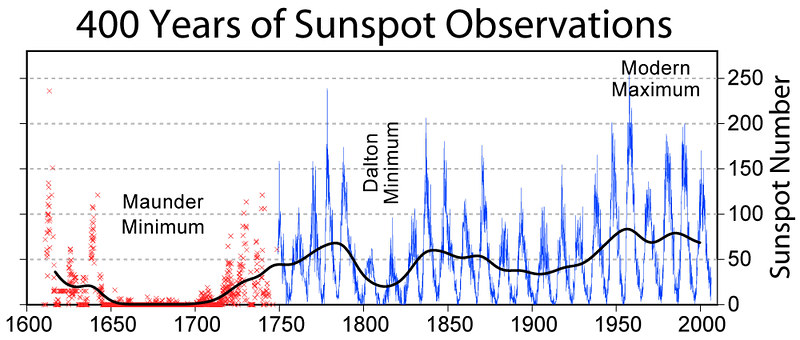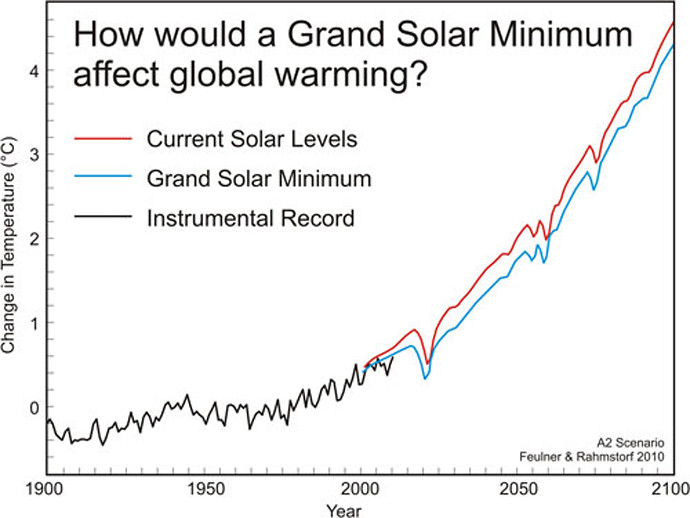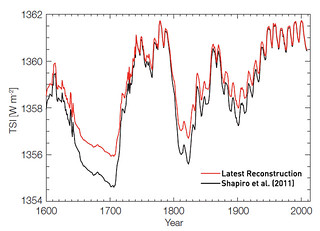Mini ice age doesn't loom, as some suggest. Here's why
Meteorologist/Science Writer
Tuesday, July 14, 2015, 6:21 PM - Astronomers have a forecast for the next Grand Solar Minimum in our Sun's sunspot cycle, but contrary to some reports in the media, this will not bring about a "mini ice age" as a result.
Based on a new astronomical model of our Sun, produced by a research team from Northumbria University, in the UK, our Sun's "irregular heartbeat" is apparently governed by a "dynamo" produced by the interaction of two different layers inside the star - one deeper down and one closer to the surface.
"We found magnetic wave components appearing in pairs, originating in two different layers in the Sun’s interior," Prof. Valentina Zharkova, of the Northumbria University, said at the National Astronomy Meeting in Llandudno, according to the Royal Astronomical Society (RAS). "They both have a frequency of approximately 11 years, although this frequency is slightly different, and they are offset in time. Over the cycle, the waves fluctuate between the northern and southern hemispheres of the Sun. Combining both waves together and comparing to real data for the current solar cycle, we found that our predictions showed an accuracy of 97%."
A Solar Forecast?
Based on this model of the Sun, Zharkova has estimated when these two layers of the Sun will line up to produce another "Grand Solar Minimum."
"In cycle 26, the two waves exactly mirror each other – peaking at the same time but in opposite hemispheres of the Sun. Their interaction will be disruptive, or they will nearly cancel each other. We predict that this will lead to the properties of a ‘Maunder minimum’," Zharkova said, according to the RAS press release. "Effectively, when the waves are approximately in phase, they can show strong interaction, or resonance, and we have strong solar activity. When they are out of phase, we have solar minimums. When there is full phase separation, we have the conditions last seen during the Maunder minimum, 370 years ago."
Having a reliable way to forecast the strength of solar minimums and maximums would certainly be helpful, especially to warn us of an impending extreme solar maximum (and the potential for intense solar flares and coronal mass ejections), however nothing in Prof. Zharkova's study mentions anything about the effect of another extreme minimum on global temperatures.
This connection was made by those attempting to spread a rather persistent myth about climate change - the myth that the Sun, and sunspot activity, is responsible for current trends in global warming and thus climate change.
WATCH BELOW: Dan Lubin, research physicist from Scripps Oceanographic Institute, speaks about the effect of an extreme solar minimum on future global temperatures.
Sun's effect on climate?
Our Sun, the source of nearly all the energy that goes into Earth's climate and ecosystem, has what astronomers refer to as an "irregular heartbeat." Every 11 years, the pattern of sunspots on the surface of the Sun goes from a peak maximum to a minimum and back to another peak maximum. However, every once in awhile, irregularities crop up, causing stronger peaks and weaker minimums - such as the "modern maximum" that's occurring now and the "Maunder minimum" that occurred during the second half of the 17th century.

Graph of sunspot numbers from 1600 to present, indicating the Maunder and Dalton Minimums. Credit: Robert A. Rohde/Global Warming Art project/Wikimedia Commons
During solar maximums, when there is the highest number of sunspots, the Sun's energy output is also higher than normal. This means that there's slightly more energy arriving at the top of Earth's atmosphere, and so there's slightly more energy going into Earth's climate system and ecosystem. During a solar minimum, sunspot activity drops to near zero, and the Sun's output is slightly lower. How much higher and lower?
|
|
Based on the graph to the right, over the past 60-70 years, the amount of solar radiation received at the top of the Earth's atmosphere (solar irradiance, measured in Watts per metre squared or W/m2), has been fairly stable, varying by less than one tenth of one percent from average at solar minimum and solar maximum. In the late 1600s, during the Maunder minimum, solar irradiance was about a third of a per cent below current levels, and there was very little variation over that half-century. Sunspot activity and solar irradiance remained low, with no typical minimums and maximums throughout.
What did this do here on Earth?
When the Maunder Minimum occurred, climate records show that the Earth (or at least parts of the Northern Hemisphere) was in the middle of what is known as "The Little Ice Age." This wasn't a true ice age, like was seen on Earth tens of thousands of years ago, with a global expansion of glaciers and ice sheets. Instead, it was simply a period where parts of the world experienced slightly colder winters than normal and a few periods of cool summers. Different regions experienced these changes at different times, however, likely making this more of a local climate effect rather than an overall global one.
Temperatures during these periods - mainly through North America, Europe and Central Asia - were roughly 1oC cooler, on average, than temperatures seen today. While the solar cycle may have played a small part in these temperature differences, there is strong evidence that several volcanic eruptions - 10 in all between the middle of the 13th century to the beginning of the 19th century - pumped a significant amount of sulphur dioxide into the atmosphere, which is known to block solar radiation and cause a global cooling effect. Combined with other effects, such as small changes in the Earth's tilt, and shifts in global ocean circulation patterns, solar irradiance only becomes one of several factors in play at the time.
Also, without the current levels of greenhouse gases - CO2 levels were around 275 ppm during the Little Ice Age, compared to over 400 ppm today - solar irradiance may have been able to have more of an impact on the climate. Today, though, it has been shown that greenhouse gases are the major forcing behind the current rise in global temperatures.
Simply looking at the effects of a solar minimum, though, studies in 2010, 2012 and in June of 2015 have shown that the contribution of such extreme minimums in the solar cycle would likely have only been around 0.25-0.3oC.

Effects of reduced solar irradiance, based on Feulner and Rahmstorf (2010). Courtesy: SkepticalScience.com
The above graph, from the 2010 study, by Georg Feulner and Stefan Rahmstorf of the Potsdam Institute for Climate Impact Research, shows the effect on global temperatures of a future "Grand Solar Minimum" - that same 0.25-0.3oC.
Global warming is expected to contribute between 1.0-5.0oC to global temperatures by the year 2100 (depending on what we do, or don't do, about our increasing emissions). An extreme solar minimum by 2030 might help us in the case of the more optimistic of those projection, if we can start an aggressive strategy of emission reductions. However, if temperatures rise higher than that - and they likely will - a quarter to a third of a degree won't help us much.
In either case, the effects of an extreme solar minimum would have to completely overwhelm the projected warming to actually cause a mini ice age, and the chances of that are extremely low.
Note: the video leading off the story is a general guide to the Sun's solar cycle and sunspot cycle, produced in 2011. In 2015, the Sun is currently past its latest maximum (which took place in 2013), and is ramping down towards solar minimum, which should be reached by the end of the decade. Where the solar cycle goes from there isn't yet known.
Sources: Royal Astronomical Society | PMOD | Skeptical Science | IPCC




